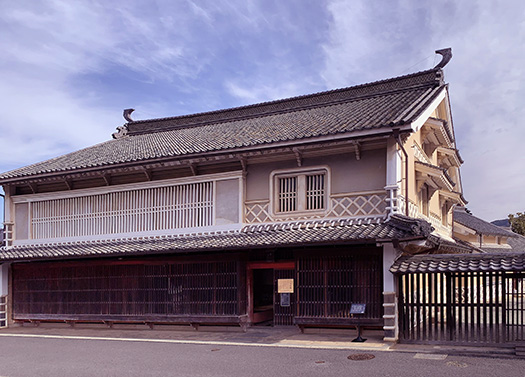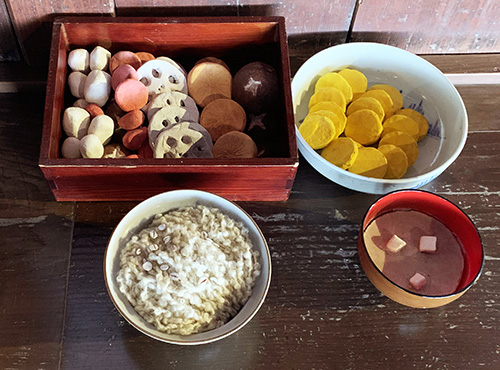

明治期の海外貿易において木蝋という産業の位置がどういったものであったか、
その概観を捉えることから、残された建築への理解は始まるでしょう。
現地では概要のおはなしは説明員の方から聞いたけれど、
いろいろと周辺事実を探っていくことでリアリティが高まります。
撮影写真と記録の掘り起こしでタイムスリップ型住宅取材が可能になる。
明治期以降の事跡については各種の資料が残っている。
以下、愛媛県史・社会経済3より要旨抜粋。
「木蝋の盛衰」
〜優秀な製品で知られた愛媛の木蝋は明治2年には白蝋100斤(60kg)30円以上、
生蝋100斤25円だったものが、暴落して10円と8-9円台になった。
が、その後海外輸出の途があることがわかり販路拡大に努めた結果、
価格も上昇し白蝋100斤15-6円、生蝋100斤12-3円となった。
愛媛県の木蝋は大阪・神戸の外国商人の手により九州の製品と混同して
中国上海に輸送され、さらに欧米各国へ再輸出された。
内子町の芳我弥三衛は明治26年アメリカ・イリノイ州シカゴ博覧会に出品し
褒賞を受けた。その当時の経営規模は使用者67人、年間産出額150万斤(900トン)、
価格225,000円と記録。また明治33年(1900)パリ博覧会でも銅メダルを受賞。
明治7年の『府県物産表』によると木蝋275,312貫余、115,343円余。
晒蝋36,050斤、3,271円、蝋燭167,294斤、17,171円余、
鬢付油68,419斤、995円36銭となっていた。
明治20年の『愛媛県農商工統計年報』では木蝋製造家が全県で369戸余。
喜多郡109、西宇和郡74、北宇和郡43、東宇和郡39、下浮穴郡34と続く。
喜多郡では生蝋が119,335貫(47.5トン)、晒蝋126,076六貫(472トン)、
代価260,298円と他郡を圧倒している。県全体では423,817円であった。
製造戸数は明治35年の生蝋332、晒蝋80、計412戸がピークで以後は漸減。
生蝋業者は櫨実の産に近い喜多郡と宇和四郡中心で晒蝋業者は内子町に集中。
明治28年に第一回全国木蝋業者大会が大洲町で、第二回が内子町で開かれた。〜


<写真は働いていた人たちの社員食堂献立見本>
ちなみに物価変動はあるが概算推計で明治時代の「1円」は現代の2万円。
明治30年頃、小学校の教員やお巡りさんの初任給は月に8~9円。
庶民にとって当時の1円は、現在の2万円ぐらいの重みがあったといわれる。
そのモノサシでこの家の主人・芳我弥三衛さんの事業規模を現在換算すれば、
明治26年段階で45億円程度と推計される。
海外市場を狙っての宣伝活動としてパリ万博などを利用するなど、
明治期のビジネスマンとして優秀な活動を行っていた。
「喜多郡出身の池田貫兵衛・河内寅二郎らは神戸に喜多組という貿易商社を設立」
と、上の要旨記録からも「臥龍山荘」オーナー河内寅二郎の名も出てくる。
愛媛県内での事業者たちの活動の実像がみえてくる。
English version
[Meiji period export product “Japan wax” business operator’s house ② Shikoku living space-40]
Photographing at a visiting house and verification of records for interviews. Time-slip type housing coverage, today we are exploring the scale of business and money.・ ・ ・
What was the position of the industry of Japan wax in foreign trade during the Meiji era?
Understanding the remaining architecture will begin by capturing that overview.
I heard the outline of the story from the explanation staff at the site,
Reality will be enhanced by exploring the surrounding facts in various ways.
Time-slip type housing coverage will be possible by digging up photographs and records.
Various materials remain about the traces after the Meiji era.
The following is an excerpt from Ehime Prefecture History / Socio-Economy 3.
“The rise and fall of Japan wax”
~ Ehime Japan wax, known for its excellent products, was 100 loaves of white wax (60 kg) for 30 yen or more in the 2nd year of the Meiji era.
The price of 100 loaves of raw wax was 25 yen, but it plummeted to 10 yen and 8-9 yen.
However, as a result of trying to expand the sales channel after finding out that there was a way to export overseas,
The price also increased to 15-6 yen for 100 loaves of white wax and 12-3 yen for 100 loaves of raw wax.
Japan wax in Ehime prefecture is confused with Kyushu products by foreign merchants in Osaka and Kobe.
It was shipped to Shanghai, China, and then re-exported to Western countries.
Yasami Higa from Uchiko-cho, Kita-gun exhibited at the Chicago World’s Columbian Exposition in Illinois, USA in 1897.
He was rewarded. At that time, the management scale was 67 users, and the annual output was 1.5 million loaves (900 tons).
The price is recorded as 225,000 yen. He also won a bronze medal at the 1900 Paris Exposition.
According to the “Prefectural Product List” of the 7th year of the Meiji era, Japan wax is 275,312 pieces and 115,343 yen.
Sarashi wax 36,050 loaves, 3,271 yen, candles 167,294 loaves, over 17,171 yen,
It was 68,419 loaves of oil with sardines and 995.36 yen.
According to the “Ehime Prefecture Agricultural Commerce and Industry Statistics Annual Report” in 1890, there were more than 369 Japan wax manufacturers in all prefectures.
It is followed by Kita-gun 109, Nishiuwa-gun 74, Kitauwa-gun 43, Higashiuwa-gun 39, and Shimoukena-gun 34.
In Kita-gun, raw wax is 119,335 pieces (47.5 tons), bleached wax is 126,076 pieces (472 tons),
The price is 260,298 yen, which overwhelms other counties. It was 423,817 yen for the entire prefecture.
The number of units manufactured peaked at 332 raw wax and 80 bleached wax in 1902, and has been gradually decreasing since then.
The raw wax traders are mainly in Kita-gun and Uwa-shi-gun, which are close to the production of Hashimi, and the bleached wax traders are concentrated in Uchiko-cho, Kita-gun.
The first national wax trader competition was held in Ozu-cho in 1887, and the second was held in Uchiko-cho. ~
By the way, although there are price fluctuations, it is estimated that “1 yen” in the Meiji era is 20,000 yen in modern times.
Around 1890, the starting salary of elementary school teachers and policemen is 8-9 yen a month.
It is said that 1 yen at that time was about 20,000 yen for the common people.
If the business scale of the owner of this house, Yasami Haga, is currently converted with that monosashi,
It is estimated to be about 4.5 billion yen in the 26th year of the Meiji era.
For example, using the Paris Expo as a promotional activity targeting overseas markets, etc.
He was an excellent activity as a businessman in the Meiji era.
“Kita-gun Ikeda Nukibei, Kawauchi Torajiro and others established a trading company called Kita-gumi in Kobe.”
And, from the above summary record, the name of “Garyu Sanso” owner Torajiro Kawauchi also comes out.
You can see the real image of the activities of businesses in Ehime prefecture.
Posted on 4月 4th, 2022 by 三木 奎吾
Filed under: 住宅マーケティング, 日本社会・文化研究








コメントを投稿
「※誹謗中傷や、悪意のある書き込み、営利目的などのコメントを防ぐために、投稿された全てのコメントは一時的に保留されますのでご了承ください。」
You must be logged in to post a comment.